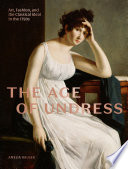2018 School Spending Survey Report
The Age of Undress: Art, Fashion, and the Classical Ideal in the 1790s
COPY ISBN
VERDICT This title will engage readers of costume scholarship as well as historians focused on the turn of the century. There is much to learn from the well-researched text, and the book is easy to browse for its rich images that exemplify the time period.
RELATED
ALREADY A SUBSCRIBER? LOG IN
We are currently offering this content for free. Sign up now to activate your personal profile, where you can save articles for future viewing




Comment Policy:
Comment should not be empty !!!